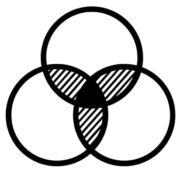SPaM for Curriculum Design & Planning
Graphical versions of the framework and slides versions are available here: https://spam.digisim.uk/portfolio/spam-graphic/
Activity 1 – Dinner Party Design
Imagine you are holding a dinner party, one where you are asking all of your guests to bring food/drink to the dinner to make it a rich and enjoyable experience – we’re going to apply that analogy to SPaM. Read a bit more here: https://spam.digisim.uk/generic/dinner-party-design/
In the context of course/curriculum design and planning it’s important to make sure that you have all the expertise “at the table” so that the discussions are informed and the course designed process is effective and informed, especially where you are blending modes.
In the context of SPaM think about who will bring what expertise to the “table”.
- Using the SPaM framework as a reference point, in small groups list the types of roles which might bring some expertise to each of the three core SPaM domains.
- Some roles may be able to bring skills and knowledge to more than one domain, you might map these to the domain interplay areas.
- If a role brings expertise to more than one domain then also identify which domain it would be bringing most expertise to.
- Are there any SPaM domains where you have identified limited expertise? Where else might you draw this from?
- Make sure to include external stakeholders too (e.g. an employer might bring expertise to the subject domain).
- Discuss with the group where you feel you could bring most expertise to a curriculum design dinner party!
Activity 2: Domains – going deeper.
The SPaM Framework is structured around three core domains, each of which have layers of complexity, which are discussed briefly on the website (links below):
- Take each domain in turn and write down any sub-topics / sub-categories that exist within that domain.
- e.g. in Pedagogy a sub category might be “assessment” and a sub-sub category might be “authentic assessment”. Get as much detail as you can.
- You might cluster these into themes.
- Identify specific categories that sit across the interplay areas of domains
- e.g. “Digital Pedagogy” would sit in the interplay area of Pedagogic-Modality.
- What is the balance of these sub-categories you have identified? Do you have more in one domain than the other? What are implications for
Activity 3: Design a learning experience.
As well as working at a curriculum level the SPaM Framework can also be used to design sessions. This activity examines the way in which the interplay of the SPaM domains influence each other. You will develop a design overview for a topic-based learning experience, mapping it to the SPaM framework.
- To start with you will select a signle teaching mode to work with. (e.g. In-Person On Campus / Online Synchronous / Online Asynchronous)
- Identify a couple of learning objectives for the topic, based on the topic of your choice (i.e. identify what you want students to know at the end of the topic).
- Identify an assessment task (formative) that you will use to “measure” their learning.
- Outline the learning activities and resources you might use to teach this topic.
- Now choose a different teaching mode – what would you change about your design and what would you keep?
- Finally – if you mix modes what aspects of the design would work best within each mode. What does the best hybrid experience look like when you make the best use of all three modes?
Downloadable PDF below:
